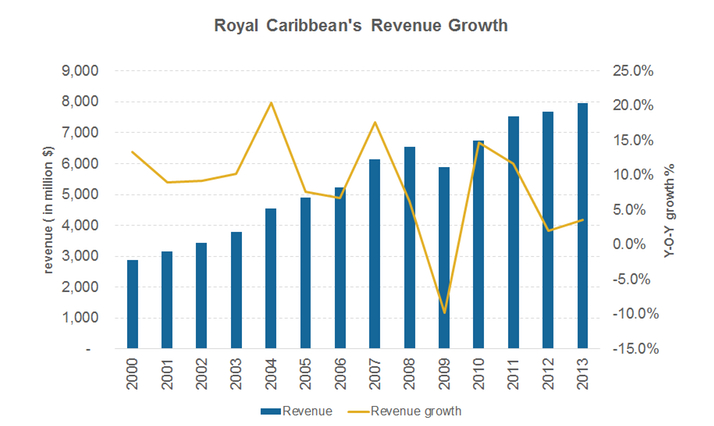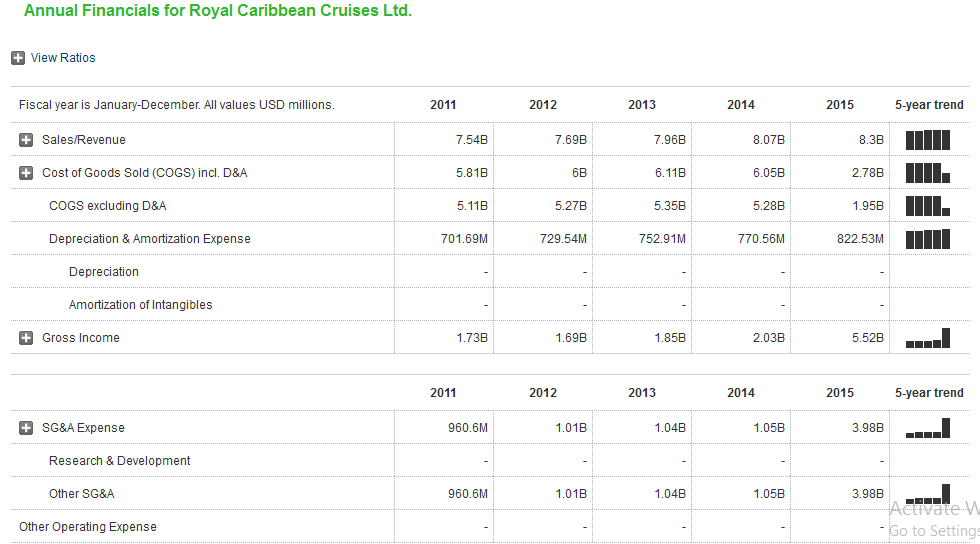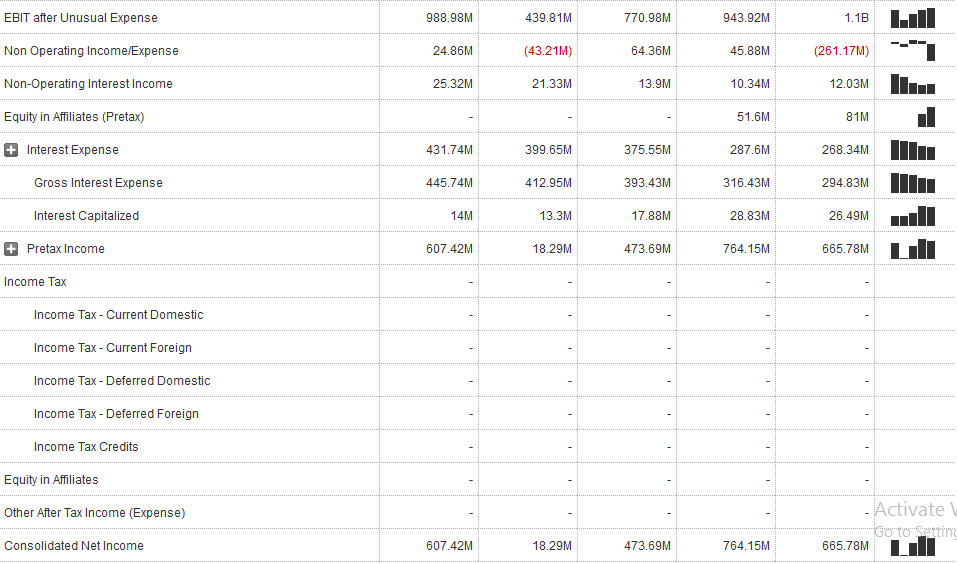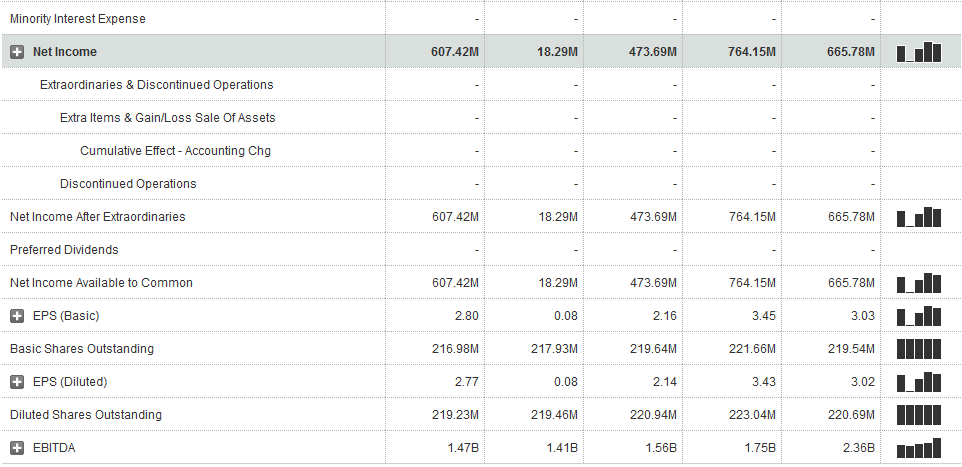Executive Summary
This paper is a business strategy analysis of Royal Caribbean Cruise Company, which is the second largest cruise company in the world. Its business success mostly hinges on an elaborate market segmentation strategy that generates revenues by selling different types of products to different types of clients. The same broad business strategy has seen the company offer multiple cruise packages to suit the needs of different types of clients.
Based on this strategy, this paper proposes that the company needs to focus on building its business around emerging markets because this is where most of the potential for market growth exists. Furthermore, based on a review of Royal Caribbean’s external market (PEST analysis) and internal market (SWOT) analysis, we find that focusing on the social media strategy should be the first strategic choice of the company because it aligns with its growth trajectory and capabilities. Particularly, this paper draws our attention to Asia, where the greatest potential for growth exists and demonstrates that focusing on this market would require the effective execution of a robust social media-marketing plan.
Introduction
The Royal Caribbean Cruise Company is arguably one of the leading cruise companies in the world. Founded in 1968, the shipping company has six brands, which provide contemporary and premium cruise packages to different groups of customers (Cederholm 2015). This paper evaluates the company’s business level generic strategies, directions of strategic development, and strategic factors affecting the execution of its business plan. The goal of this assessment is to provide solutions for enhancing the company’s strategic focus.
Business Level Generic Strategies
Royal Cruise Company’s passenger market mix includes three main components – a broad passenger market mix, an elaborate internationalisation strategy, and a robust technological strategy.
Passenger Market Mix
Royal Cruise Company’s strategy mostly focuses on increasing brand awareness to different groups of customers (Fabbi 2013). This strategy also includes capitalising on the portability and flexibility of its ships to exploit different market opportunities in different parts of the world. The aim of this strategy is to exploit new market opportunities, while at the same time catering to the needs of the local market (Mancini 2010). It also aligns with the company’s quest to expand its passenger market mix.
Internationalisation Strategy
As part of its generic business strategy, the Royal Caribbean Company has six different types of ships to cater to different customer segments (Cederholm 2015). Most of them are in different locations around the world to provide prompt services to its varied customer groups. Traditionally, the company has mostly focused its marketing strategy in the United States, but as of 2008, the number of ticket sales outside the states has steadily grown from 40% to 46% (Cederholm 2015).
Royal Cruise Ship’s international marketing strategy has seen it establish offices in different countries around the world, including some of the world’s top tourist destinations, such as Mexico, Spain, Australia, Brazil and Italy (among others) (Turner 2005). The company’s quest to be more responsive to local market needs has informed this strategy.
Technology
The use of modern technology to deliver quality services and to improve customer experience has been a key component of Royal Cruise’s strategy (Cederholm 2015). The company has also incorporated some of the latest technologies in its ships by creating VIP areas for celebrities (Celebrity iLounge) where guests use their technological gadgets without disturbance. The technological strategy also aligns with its international strategy because the company has redesigned some of its websites for international markets to respond to the customer needs of different market segments (Cederholm 2015).
Directions of Strategic Development
Based on the above findings, Royal Cruise Company should focus on exploiting the market potential of unexplored markets, expand its relationship with tour operators, and embrace social media to increase its market share. The justification of these recommendations appears below
Focus on Underexplored Markets
Royal Caribbean should focus on increasing its market penetration strategy to unexplored markets, such as Asia (Chon 2013). So far, the company’s strategy has only focused on Europe, America, and Australia. It needs to expand its market scope and include emerging markets, in Japan, China, and other Asian countries, where there is a growing middle class (Papathanassis 2016).
How would it do so?
Royal Caribbean should explore unexplored markets in Asia by increasing brand awareness in the region. It could effectively do so by adopting effective marketing strategies centred on digital marketing.
Expand its relationship with Tour operators
Royal Caribbean should liaise with travel agents and develop a good relationship with them to increase its market scope. This strategy would be a departure from its traditional model of relying on a direct consumer outreach strategy that allows it to prospect for new customers without the input of third parties. The company needs to adopt the new strategy because tour operators are the veins of the tourism industry and they outline the customer distribution network in the industry (Beaver 2005).
How would it do so?
Royal Caribbean should expand its network of tour operators by including them as partners and not as third parties. Therefore, for every business they get, the operators would get a commission for their work (Campbell, Stonehouse & Houston 2000).
Embrace Social Media
Royal Cruise targets young partygoers and families who have a liking for adventure and fun. In this regard, the company has a broad range of clients who allow it to diversify its revenue pool, as it could get money from anyone who wishes to take a cruise. The company should enhance this strategy and embrace a strong social media-marketing plan to increase its market share (Evans 2012).
How would it do so?
Instead of focusing on a general marketing strategy, Royal Caribbean needs to gather information about its clients through social media (mostly Facebook and Twitter) and develop a target market that would better respond to its products (Vogel, Papathanassis & Wolber 2012).
Strategic Factors Affecting the Company and their Influence on the Suitability of the Strategic Options
PEST Analysis
Political
Royal Caribbean is under pressure to reduce its carbon footprint from environmental authorities around the world. This is why different countries and environmental authorities are formulating new laws to regulate the environmental impact of the company and its rivals (Hoskisson, Hitt & Ireland 2008).
Economics
The global economic environment has affected different players in the tourism industry through fluctuations in demand and price adjustments. The Royal Caribbean Cruise Company is no exception. Since the 2007/2008 global economic crisis, the company has had re-evaluate its business strategies to meet changing customer preferences and to adapt to the current economic environment.
As part of the strategy to adapt to these external market dynamics, the company has improved the attractiveness of its products and included more variety to its dining packages and entertainment options (Fabbi 2013). The goal of doing so has been to reduce the cost of travel, especially air travel, thereby providing a more fun and affordable way of travelling.
Socio-Cultural
The unpredictable nature of security has created increased concerns regarding the safety of passengers aboard cruise ships. For example, piracy and terrorism have been at the top of the list of the major concerns that would create reluctance for customers to take long cruises (Vogel, Papathanassis & Wolber 2012, p. 237). In response to such concerns, the company has taken extra measures to increase passenger safety. However, some people are not fully convinced to book the services, despite the new measures taken (Mancini 2004; Weidner 2010).
Technology
Most cruise companies have installed some of the latest technological services, such as WiFi, on their vessels (Mancini 2004). The ships are also equipped with wireless telephones for communication. However, their fees are often high. There are also interactive televisions across different areas of the vessel, providing the customers with entertainment whenever they need it. Although some of these technologies are old, cruise ship companies are part of the “green revolution,” as they are now using energy efficient engines and constructing eco-friendly structures (Mancini 2010).
The Royal Cruise Ship Company is particularly paying a close attention to this fact because, in 2008, authorities fined it for contaminating the sea by discharging oil and falsifying reports about this action (Cederholm 2015).
SWOT Analysis
The table below shows a summary of Royal Cruise’s SWOT analysis
Financial Performance
Since 2011, the Royal Cruise Company has posted a positive financial performance that emanates from the recovery of the tourism sector after the 2007/2008 global financial crisis. For example, an assessment of the company’s profitability reveals that its gross income increased from $1.73 billion to $5.52 billion (Market Watch 2016). Its earnings before interest and tax also followed the same pattern because it increased from $1.47 billion in 2011 to $2.36 billion in 2015 (Market Watch 2016). The table below shows the company’s revenue growth over the past decade:

The year 2015 was the second year that the company remained on track to accomplish its goal of doubling its adjusted earnings per share. The company’s management is optimistic that this trend will continue up to 2017. Indeed, according to its 2015 financial report, it is on track to achieve double-digit return on invested capital by 2017 (RCL 2016, p. 45). Relative to this assertion, the company reported, “the year 2015 was another record year for our company, as adjusted earnings grew by more than 40% year-over-year for the second consecutive year” (RCL 2016, p. 45).
Part of the company’s financial success has stemmed from its continued quest to decrease its expenditure. The low cost of crude oil prices in 2015 and 2016 has helped to further cement this advantage (RCL 2016). Appendix 1 and a comprehensive review of the company’s 2015 annual report (cited in RCL 2016) emphasize the company’s positive financial performance.
Preferable Approach
Based on a review of Royal Caribbean’s external market (PEST analysis) and internal market (SWOT) analysis, we find that focusing on the social media strategy should be the first strategic choice of the company because it aligns with its growth and capabilities.
Key Issues for Implementing the Social Media Strategy
The financial performance analysis section has proved that the company is on track to post more numbers that are positive in the future. The adoption of social media marketing would be a step towards meeting this goal. Furthermore, it would elevate the company’s brand name in promising markets, such as Asia that have not traditionally been accustomed to cruises, as a luxury holiday product (Zarrella 2009).
To do so, the company needs to advertise on Facebook and Twitter, which are the main social media marketing platforms in the world. In these platforms, it should develop online videos with an option of “sharing” where customers speak about their experience cruising and where viewers could see the kinds of activities they would engage in when travelling to different destinations. The company also needs to engage in online conversations about its brand.
Conclusion
Going forward, the Royal Caribbean Cruise Company needs to focus on building its business around emerging markets because this is where most of the potential for market growth exists. Particularly, this paper draws our attention to Asia, where the greatest market potential exists. However, doing so would require the effective execution of a robust social media-marketing plan.
References
Beaver, A 2005, A Dictionary of Travel and Tourism Terminology, CABI, Massachusetts.
Campbell, D, Stonehouse, G & Houston, B 2000, Business Strategy: An Introduction, Butterworth-Heinemann, London.
Cederholm, T 2015, Overview: Royal Caribbean Cruises, the 2nd largest cruise operator. Web.
Chon, K 2013, Tourism in Southeast Asia: A New Direction, Routledge, London.
Evans, D 2012, Social Media Marketing: An Hour a Day, John Wiley & Sons, London.
Fabbi, M 2013, Royal Caribbean Cruise Line (RCCL) – A Brand Portfolio Analysis, GRIN Verlag, New York.
Hoskisson, R, Hitt, M & Ireland, M 2008, Business Strategy: Theory and Cases, Cengage Learning, London.
Mancini, M 2004, Cruising: A Guide to the Cruise Line Industry, Cengage Learning, London.
Mancini, M 2010, The CLIA Guide to the Cruise Industry, Cengage Learning, London.
Market Watch 2016, Royal Caribbean Cruises Ltd. Web.
Papathanassis, A 2016, Cruise Business Development: Safety, Product Design and Human Capital, Springer, New York.
RCL 2016, Annual Report 2015. Web.
Turner, T 2005, Vault Guide to the Top Hospitality & Tourism Industry Employers, Vault Inc., New York.
Vogel, M, Papathanassis, A & Wolber, B 2012, The Business and Management of Ocean Cruises, CABI, New York.
Weidner, S 2010, Risk Management for Small and Medium Sized Incoming Tour Operators, GRIN Verlag, New York.
Zarrella, D 2009, The Social Media Marketing Book, O’Reilly Media, Inc., New York.
Appendix


